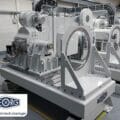The reliable route to IEC 61850
Introducing digital substation solutions that meet the international communication protocol standard IEC 61850 has the potential to improve efficiency throughout the entire lifecycle of equipment. As with any technical innovation, the introduction of IEC 61850 requires a high level of commitment to systematic preparation and implementation. Here, Stefan Hufnagl, Energy Industry Specialist at industrial automation software provider COPA-DATA, explains why laying the right organizational foundations is essential to creating a digitalization initiative that meets IEC 61850.
A growing number of projects in the energy sector include the requirement for IEC 61850 ― an international standard defining communication protocols for electronic devices at substations. This standard forms a reference system that goes beyond the communication function of an individual equipment component.
More specifically, IEC 61850 focuses on the reliability of the equipment and increases the measure of established networks and the maintainability of a product through organized functions. By following the requirements set out in IEC 61850, energy companies can benefit from more sustainable digitalization, simpler processes and more flexible equipment.
What to know before implementing IEC 61850
Typically, solutions that meet IEC 61850 are closely examined in laboratory setups or pilot plants — pre-commercial production systems that employ new technology — to develop architectures and processes to gain insights into how components from different manufacturers interact.
Commonly known, existing equipment in the energy industry cannot usually be equipped with new technology in a single pass. Therefore, IEC 61850 is gradually implemented via partial renovations, before being expanded over time to cover a whole system or, in this case, a substation.
However, these systems must be compatible with certain devices and communication protocols, such as DNP3, IEC 60870 or MODBUS. This is an essential step in establishing whether a company is ready to gradually advance its equipment digitalization journey, while continuing to operate already established systems reliably until they are replaced.
Software for sustainable development
When it comes to digitalizing substations and their subcomponents, automation software can offer options for several purposes. For example, software can connect protection technology devices to systems at stations and at network control level, regardless of the device type or manufacturer.
In fact, IEC 61850 is already implemented in COPA-DATA’s zenon automation software platform for substations. As an HMI or as a communication gateway, zenon uses MMS communication to visualize process and control data or, if required, to forward this data to higher-level network control rooms.
The zenon software platform is developed as a manufacturer-independent system to provide a basis for scalable energy solutions based on IEC 61850. For instance, new equipment implemented with IEC 61850 can be operated using zenon in the same way as hybrid systems, which has various existing components.
For energy companies, zenon creates scope for constant sustainable development as part of a digitalization plan with manageable investment. This means that companies do not need to go all in when it comes to either the extent of the investment, or the choice of a protection component manufacturer.
This makes introducing digital substation solutions based on IEC 61850 simpler and more cost-effective. After all, the introduction of IEC 61850 requires a high level of commitment to systematic preparation and implementation, so creating a successful digitalization initiative — in line with the latest international standards — at your own pace is the reliable route to take.








